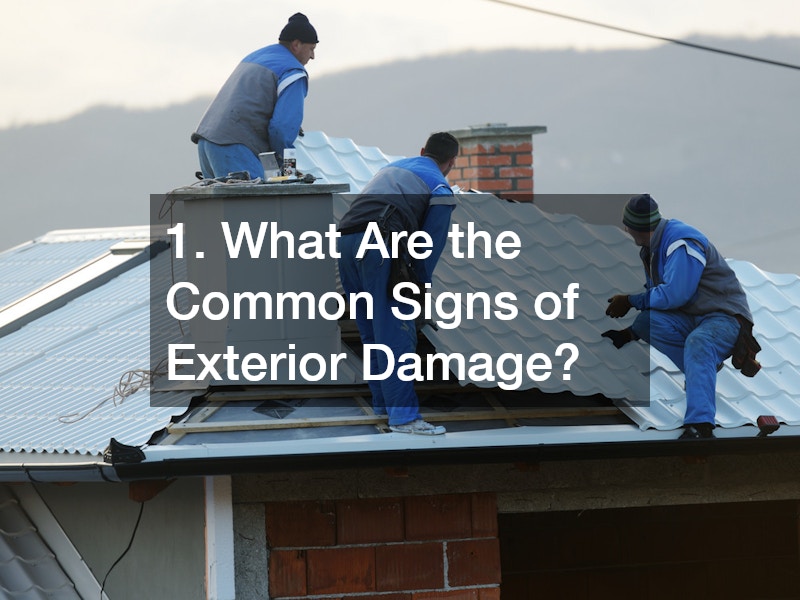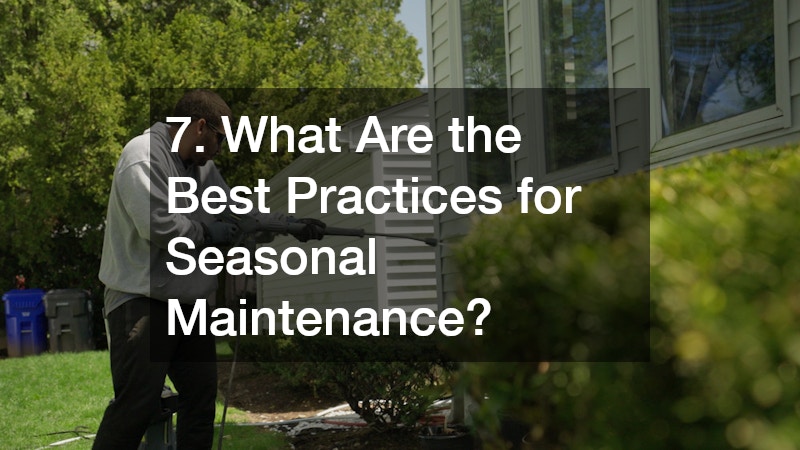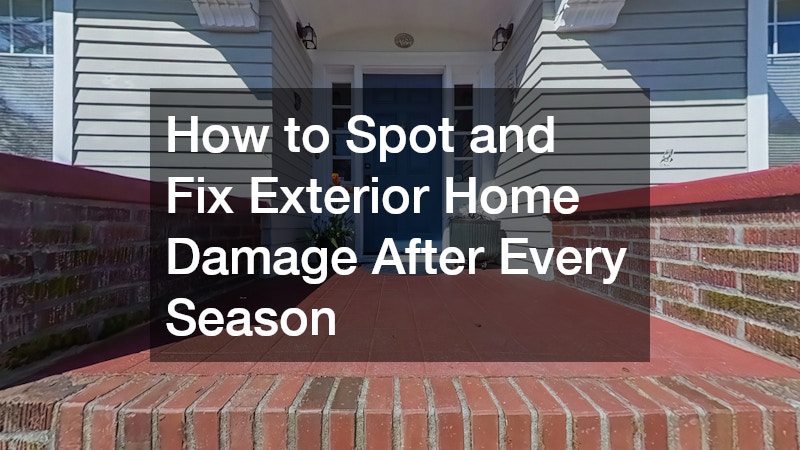Your home’s exterior faces constant exposure to the elements—wind, rain, snow, sun, and temperature fluctuations. Over time, these conditions can take a toll on your siding, roofing, windows, and overall structural integrity. While interior repairs often get more attention, exterior maintenance is what truly preserves the value, safety, and appearance of your home. Neglecting it can lead to costly problems down the road.
Learning how to identify and fix exterior home damage is one of the smartest investments a homeowner can make. Every season brings unique challenges: winter’s freezing temperatures can crack surfaces and cause leaks; spring’s heavy rains may expose roof weaknesses; summer’s heat can warp siding; and fall debris can clog gutters or downspouts. By inspecting your home regularly and addressing damage promptly, you can prevent minor issues from escalating into expensive repairs.
This guide offers a practical approach to spotting and fixing exterior damage throughout the year. From identifying warning signs to knowing when to call professional roofing companies, you’ll gain the insight needed to protect your property’s structure and beauty. Whether you plan to handle minor repairs yourself or hire specialists for larger projects, maintaining your home’s exterior ensures long-term durability, curb appeal, and peace of mind.
1. What Are the Common Signs of Exterior Damage?

The first step in preventing serious issues is recognizing early signs of exterior home damage. Over time, exposure to harsh weather can weaken materials and create subtle problems that worsen if ignored. Knowing what to look for helps you take action before damage spreads.
Roofs are often the first to show wear. Missing or curling shingles, dark streaks, or soft spots indicate potential leaks. Gutters that sag or overflow signal drainage issues that could lead to foundation damage. Cracks in siding, peeling paint, and mold growth also point to moisture infiltration. Even small gaps around windows and doors can cause drafts, water leaks, or pest entry.
It’s smart to walk around your home after every major storm or season change. Pay attention to uneven surfaces, warped boards, and any signs of deterioration. Documenting these issues with photos helps you track progression and determine when professional help is needed.
Working with professional roofing companies can provide an expert assessment, especially for roof and gutter-related issues. These specialists can spot hidden structural weaknesses and perform preventive maintenance that extends your roof’s lifespan.
2. How Does Weather Impact Exterior Home Elements?
Weather plays a huge role in the health of your home’s exterior. Each season introduces distinct conditions that can gradually wear down even the most durable materials. Understanding these patterns helps you anticipate problems and plan maintenance accordingly.
In winter, freeze-thaw cycles cause expansion and contraction that can crack masonry, stucco, and concrete. Ice dams form along roof edges, allowing water to seep under shingles. Spring rains test your home’s drainage and reveal leaks, while high winds can loosen siding or shingles. Summer’s intense UV rays fade paint, dry out sealants, and weaken roofing materials. In autumn, falling leaves clog gutters and create moisture buildup that encourages rot and mildew.
A roof replacement service can help you evaluate whether your roof materials are suitable for your climate. Some materials, like asphalt shingles or metal roofing, handle temperature swings better than others. Choosing the right materials can reduce seasonal damage and improve energy efficiency.
Regular inspections, particularly after severe weather events, help catch problems early. Maintaining a seasonal maintenance calendar ensures that your home remains protected year-round.
3. How to Inspect Your Roof for Seasonal Damage?
Your roof is your home’s first line of defense, yet it’s also one of the most vulnerable areas to weather damage. Performing regular inspections helps catch small issues before they become costly repairs.
Begin by visually examining your roof from the ground using binoculars. Look for missing, curled, or discolored shingles. Dark patches can indicate water pooling or algae growth. Check flashing around chimneys, vents, and skylights for cracks or separation. Inside your attic, inspect for water stains or damp insulation—these often point to hidden leaks.
If you’re comfortable with heights, you can perform a closer inspection with caution, but for most homeowners, hiring roofing contractors is the safer and more effective approach. These professionals can detect issues like granule loss, soft spots, and improper ventilation that might not be visible from the ground.
Seasonal roof inspections—especially after winter or major storms—are essential. Addressing problems early prevents structural water damage and preserves your home’s value. A well-maintained roof not only protects against leaks but also enhances energy efficiency and curb appeal.
4. What Tools and Materials Are Needed for Repairs?

Having the right tools and materials on hand can make exterior maintenance easier and safer. While many small repairs are manageable for homeowners, using proper equipment ensures durability and reduces the risk of further damage.
Essential tools include a sturdy ladder, safety harness, roofing nails, sealant, caulk gun, putty knife, hammer, and utility knife. For siding or trim work, you’ll need a pry bar, circular saw, and replacement panels or boards. Always use high-quality exterior-grade paint, weatherproof caulk, and rust-resistant fasteners.
If your roof design includes a vented roof, make sure to inspect and clean the vents regularly. Proper ventilation prevents moisture buildup in your attic, which helps regulate temperature and reduces the likelihood of mold growth or shingle deterioration.
It’s wise to create a dedicated maintenance kit for exterior repairs, storing all tools and materials in one place. Regular upkeep using the right products ensures a longer lifespan for your home’s exterior surfaces and keeps repair costs manageable.
5. How to Repair Siding and Exterior Walls?
Siding protects your home’s structure from wind, rain, and pests. When it becomes damaged, water can infiltrate and cause rot or mold, leading to expensive repairs. Regular inspections and timely fixes maintain both appearance and performance.
Start by identifying the type of siding you have—vinyl, wood, fiber cement, or metal. Each material has different repair requirements. Cracked or loose panels should be replaced immediately to prevent water penetration. For wooden siding, check for signs of rot, peeling paint, or insect damage. Damaged sections should be cut out and replaced before repainting.
Working with siding companies ensures professional installation and repair, especially if your home has extensive damage. They can match materials and colors precisely, preserving your home’s aesthetic and value.
Cleaning siding at least once a year with mild detergent and a soft brush also helps prevent buildup of dirt and mildew. Regular maintenance not only enhances curb appeal but also safeguards your home’s structural integrity for years to come.
6. How to Address Window and Door Damage?
Windows and doors are more than entry points—they protect your home from drafts, leaks, and energy loss. Over time, exposure to weather can cause warping, cracked seals, and frame deterioration.
Inspect your windows each season for condensation between panes, peeling paint, and gaps in caulking. Wooden frames should be checked for softness, indicating moisture damage. For doors, examine hinges, thresholds, and weatherstripping. Warped or damaged seals allow air infiltration that drives up energy costs.
Partnering with roofing services can sometimes help, as many roofing specialists also handle related exterior elements like flashing and waterproofing near windows. Proper sealing and flashing prevent rain from entering vulnerable wall areas.
Replacing worn caulk, repainting frames, or installing new weatherstripping are simple, affordable fixes. For severe damage, replacement may be the best long-term solution. Upgrading to energy-efficient windows or insulated doors can enhance comfort and resale value while cutting utility costs.
7. What Are the Best Practices for Seasonal Maintenance?

Consistent maintenance is the most effective way to avoid costly exterior damage. Establishing a seasonal routine ensures your home stays protected no matter the weather.
In spring, clean gutters, inspect the roof, and wash siding to remove winter residue. Summer is ideal for painting, sealing, and repairing fences or decks since warm weather helps materials cure properly. In fall, clear debris, check flashing, and prepare drainage systems for increased rainfall. Winter requires monitoring for ice dams, snow buildup, and frozen pipes.
When you discover issues, prioritize repairs by urgency. Leaks and structural damage should always come first. Partnering with a roof repairs specialist ensures that problems are addressed professionally, reducing the risk of future complications.
Keep a maintenance log to record inspections and completed work. This documentation helps you track recurring issues and can increase buyer confidence if you ever decide to sell your home. Routine upkeep is a proactive investment that protects both your finances and your peace of mind.
8. How to Prevent Damage Before It Occurs?
The best way to manage exterior damage is to prevent it in the first place. Preventive maintenance saves time, money, and stress by stopping small issues from developing into major repairs.
Regular cleaning is one of the simplest preventive measures. Remove debris from gutters, sweep porches, and wash siding to prevent moisture buildup. Trim back trees and shrubs that touch the house, as branches can scratch siding and clog gutters.
Installing roof hail protection is another smart move, especially in regions prone to severe storms. Protective materials or coatings can minimize the impact of hail, extending the life of your roof and reducing repair frequency.
Inspect sealants and paint annually to ensure they remain intact, and reseal or repaint as needed. Proper drainage is crucial—ensure water flows away from your foundation to prevent basement leaks or erosion. With consistent care and attention, your home will be far more resilient against seasonal wear.
9. What to Consider When Hiring a Professional?
Some repairs simply require expert skill and equipment. Knowing how to hire the right professionals ensures the work is done correctly and safely.
When searching for a contractor, verify licensing, insurance, and experience. Always request multiple quotes to compare pricing and scope of work. Reliable professionals should provide written estimates and timelines, along with references or reviews from previous clients.
For exterior finishes like stucco, choose specialists who understand your region’s climate and building codes. Poorly applied stucco can trap moisture and cause cracking or mold. Likewise, professional roofers, painters, and siding installers should use quality materials designed for long-term durability.
Communication is key—choose contractors who explain their process clearly and keep you updated throughout the project. Hiring reputable professionals may cost more upfront, but it prevents costly mistakes and ensures a lasting, high-quality finish.
10. How to Budget for Home Exterior Repairs?

Exterior home repairs can add up quickly, especially after severe weather or years of deferred maintenance. Setting a realistic budget helps you manage costs without cutting corners.
Start by conducting a full assessment of your home’s current condition. Prioritize critical repairs like roofing and siding before cosmetic updates. Obtain multiple estimates for major projects to understand market pricing. Keep a separate emergency fund for unexpected damage, such as storm-related repairs.
Working with local siding contractors can help you evaluate repair versus replacement options. Sometimes patching minor sections is enough, while older or severely damaged siding may need full replacement. Professionals can recommend cost-effective materials that balance durability with affordability.
If your budget is tight, spread out projects seasonally—address urgent issues first and plan aesthetic upgrades later. Financing options such as home improvement loans or credit lines can also help make large projects more manageable. Staying organized and proactive ensures you maintain your home’s value without financial strain.
Protecting your home’s exterior requires attention, consistency, and smart planning. Each season introduces new challenges, but by understanding how to spot and fix exterior home damage, you can preserve both the look and the longevity of your property.
From roofs to siding, windows to doors, timely repairs prevent small problems from escalating into costly replacements. Partnering with qualified professionals, choosing durable materials, and maintaining a regular inspection routine ensures your home remains strong and attractive year-round.
A proactive approach saves money, boosts curb appeal, and safeguards your investment for years to come. By following this guide, you’ll keep your home in top condition through every season—protected, efficient, and ready to weather whatever comes its way.




